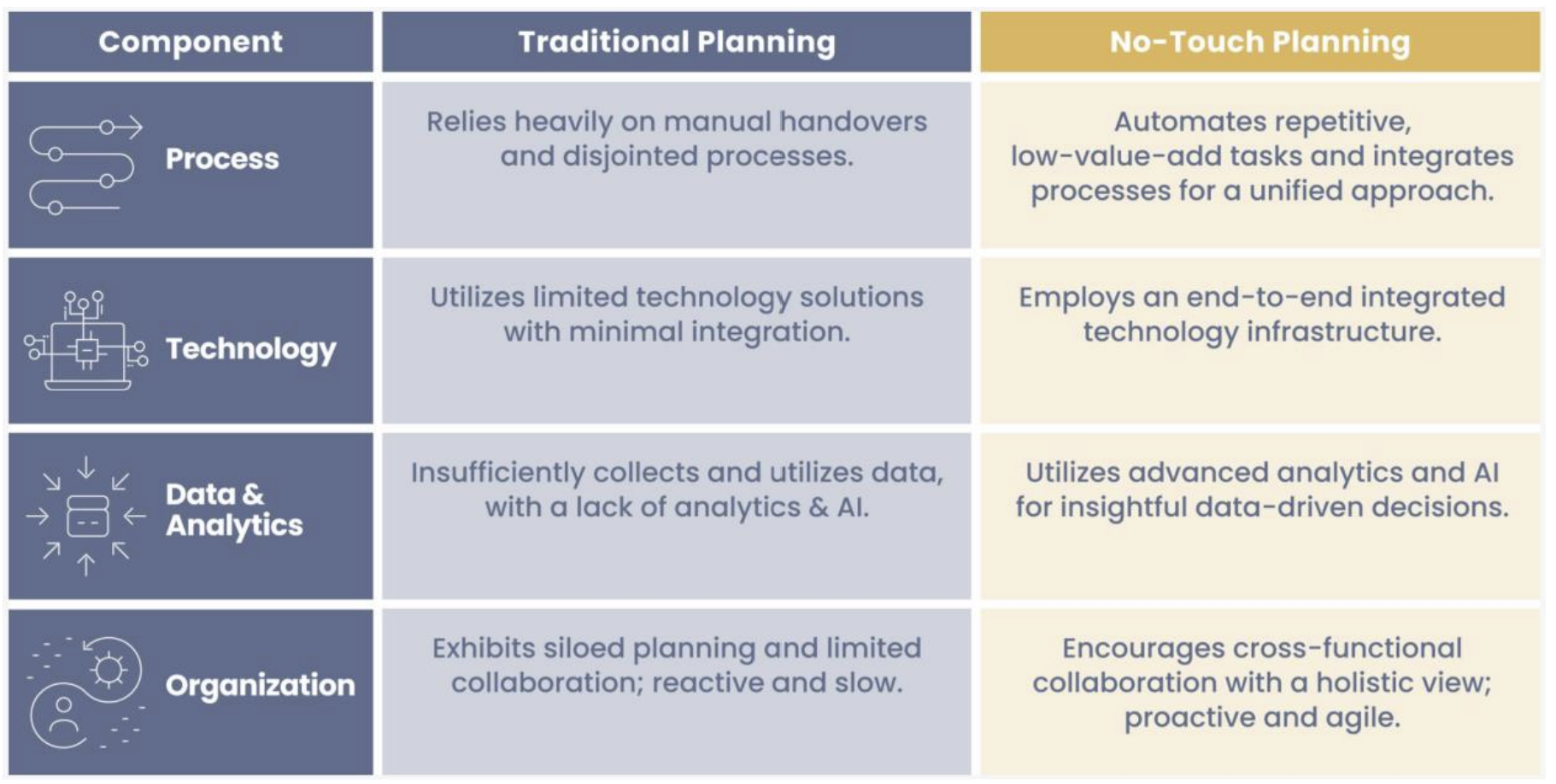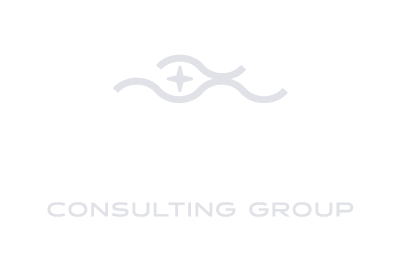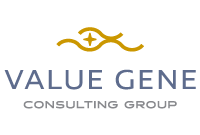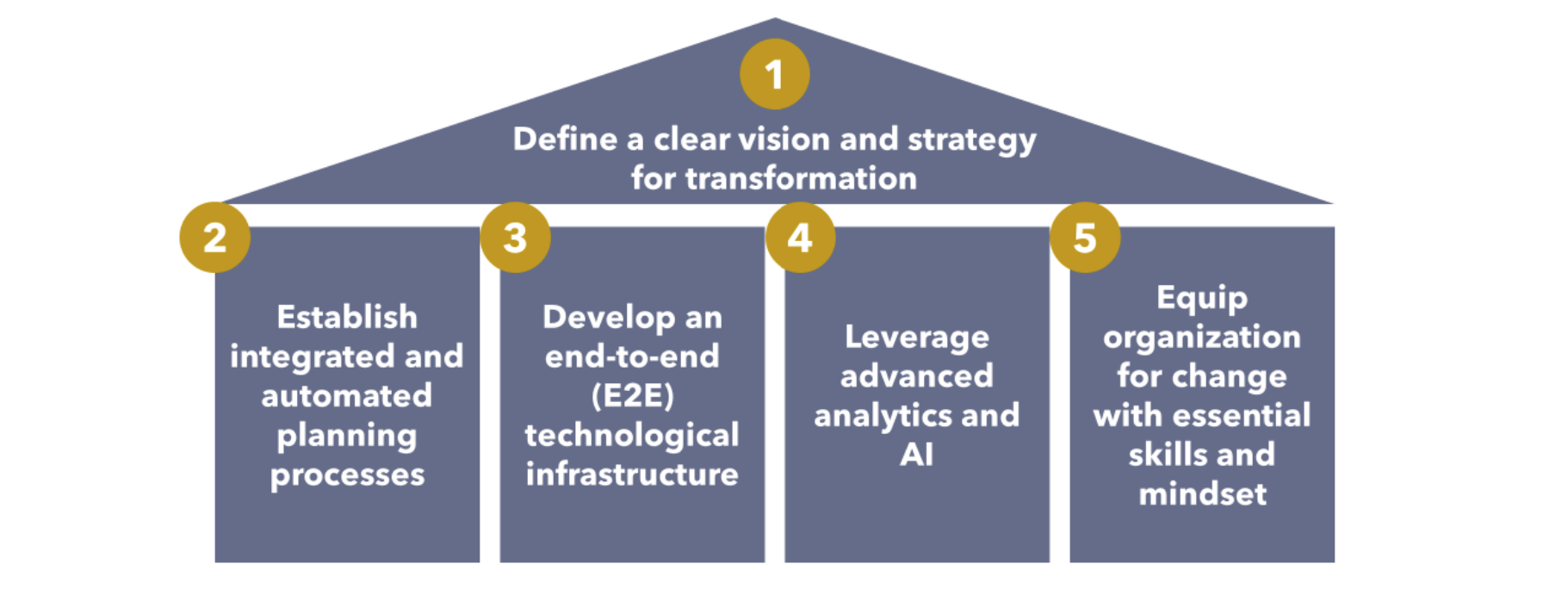The consumer goods industry is facing notable changes due to shifting market dynamics. In this fast-paced environment, traditional planning approaches are proving to be inadequate. ‘No-Touch Planning’ emerges as a highly innovative solution, offering automation, advanced analytics, and AI to significantly enhance planning efficiency and accuracy. This approach has the potential to drive substantial benefits, including up to a 5% increase in revenue, up to a 15% reduction in inventory costs, and up to a 10% increase in service levels. Embarking on this journey requires a thorough understanding of key requirements. These include having a clear vision and strategy, integrating, and automating planning processes, establishing an end-to-end (E2E) technological infrastructure, leveraging advanced analytics and AI.
By Ozan Ozaskinli, Nihan Siriklioglu, and Omer Zengin
Evolving Market Dynamics Require New Planning Approach
Consumer expectations and supply disruptions create challenges
The consumer goods industry is shifting from product-centric to consumer-centric models. Consumers now have different expectations, such as value for money, sustainability, and personalization, leading to mass customization. The rise of online channels has significantly expanded the availability of options. Additionally, consumers now expect to experience new products immediately, placing significant pressure on companies to ensure higher product availability on shelves and faster deliveries. These rising consumer expectations necessitate a deep understanding of demand, faster go-to-market, and the flexibility to adapt to the changing demand and market dynamics quickly.
On the supply side, there are continuous challenges that require supply chain agility and resilience. The volatility in commodity prices is putting price pressure on the Cost of Goods Sold, demanding optimized sourcing and cost-efficiency. Geopolitical uncertainties and environmental disasters require high visibility on suppliers and prompts the need for supplier diversification and the development of versatile business scenarios. Additionally, increasing competition, which tightens the margins, requires companies to compete for efficiency and speed.
In navigating these increasing consumer expectations and supply chain pressures, companies face competing priorities of enhancing service levels, achieving cost efficiency, and managing cash flow. Overestimating demand risks inventory surpluses or waste of perishables, while underestimating it can cause stock outs. Poor supply and inventory planning can lead to delayed deliveries and extended lead times. Such situations typically have one of the two major consequences: lost sales or additional costs.
Traditional planning approaches are no longer sufficient
In today’s fast-paced market, traditional planning approaches fall short, failing to deliver the desired outcomes. Traditional planning approaches suffer from drawbacks, including siloed planning, underutilization of data and analytics, disconnected manual processes, and labor-intensive tasks with limited added value. Although organizations incorporate numerous measures, checkpoints, and interventions within planning processes, these methods often fail to fully eliminate inefficiencies. These inefficiencies not only impair business performance but also contribute to employee dissatisfaction and increased turnover rates.
The Future of Planning: ‘No-Touch Planning’
‘No-Touch Planning’ emerges as the optimal approach
At this point, ‘No-Touch Planning’ emerges as the pinnacle of planning approaches to remove inefficiencies due to traditional planning. This approach revolutionizes the planning process by incorporating automation at every layer. By doing so, it significantly reduces manual intervention in repetitive tasks and data analysis, thus markedly decreasing the potential for human error. Secondly, utilization of advanced analytics and AI provides data-driven business insights, assesses different scenarios, and suggests optimal actions. Moreover, it fosters seamless integration across various business functions—including marketing, sales, supply chain, and finance—thus facilitating a dynamic and unified approach to planning.
Figure 1: Traditional Planning versus No-Touch Planning

Touch points in the planning process
The planning process involves 30 touch points requiring decisions, interventions, or actions. Traditional supply planning often demands a ‘high-touch’ approach at these points, heavily relying on human input. As a result, teams spend about 50% to 70% of their time on manual, low-value-added tasks. These tasks range from data collection and cleansing to basic data analysis, as well as distributing plans and facilitating communication across various functions.
Figure 2: The traditional planning approach involves 20 ‘high-touch’ points out of 30 touch points
No-touch planning: Vision for self-optimizing supply chain
No-touch planning represents a transformative leap in planning, harnessing the power of automation, analytics, and AI capabilities. It integrates multiple data points and input, ensuring a smooth flow of information across functions.
Imagine a typical consumer goods company; traditionally, the demand planning team manually gathers data from different functions on consumer trends, create base forecast, gather promotion, and campaign plans from sales and marketing and incorporate implications of these into the forecasts. The supply planning team then develops a supply plan based on the demand forecast, defining production locations, labor, logistics, and material requirements, and attempts to manually optimize these plans. Then, the production planning team breaks down the supply plan to create production schedules and shift plans. This is usually a back-and-forth communication process between demand, supply, and production planning teams.
In contrast, with no-touch planning, a demand forecasting tool collects internal and external data on demand drivers from various systems creating base demand forecasts. It then integrates marketing plans from the Trade Promotion Management (TPM) solution, analyzes potential implications and runs what-if scenarios. Finally, demand planning team reviews the forecast and finalizes it for the supply planning team.
Once finalized, supply planning solution automatically allocates forecast to develop production plans, define requirements for labor, logistics, and materials and accordingly populates the supply plans. As the final step, supply planning team reviews and validates the plans to ensure alignment with overall business objectives and operational capabilities.
A production planning solution automates the creation of production schedules and shift plans, eliminating the need for manual intervention. No-touch planning streamlines communication across all functions by providing a centralized platform where all commercial, operational, and financial teams can collaborate in real-time and enhances the efficiency of finalizing the production plan.
In parallel, the supply chain control tower, seamlessly integrated with other planning solutions and execution systems, provides planning teams with comprehensive visibility of operational performance. This integration is crucial in supporting their decision-making process.
Overall, such a transition can enable the company to automate 24 of the 30 touchpoints in the planning process. As a result, planning teams can now dedicate less time to routine tasks and instead focus on supervising and fine-tuning the plans, assessing different scenarios and making critical decisions.
Figure 3: No-touch planning can automate 24 of the 30 touch points in the planning process
No-Touch Planning Substantially Contributes to Business Performance
No-touch planning goes beyond mere improvements in business performance; it plays a pivotal role in transforming the entire operational performance. By automating routine tasks and optimizing decision-making processes, no-touch planning not only streamlines efficiency but also improves customer satisfaction and enhances employee engagement.
 Improvement in Forecast Accuracy Up to 20%
Improvement in Forecast Accuracy Up to 20%
No-touch planning automates the development of base forecasts and the incorporation of trade promotions and demand sensing, potentially improving forecast accuracy by as much as 20%.

Increase in Revenue Up to 5%
No-touch planning reduces stock-outs and improves service levels, which can lead to a revenue increase of up to 5%.

Increase in Service Levels Up to 10%
Efficient logistics resource planning under no-touch planning can improve on-time delivery by up to 10%, correlating with a 15% increase in customer satisfaction.

Reduction in Inventory Costs Up to 15%
No-touch planning enhances planning precision and optimizes inventory levels, which can translate into a 15% reduction in inventory costs, thanks to lower safety stocks and reduced excess inventory.

Reduction in Transportation Costs Up to 5%
No-touch planning improves logistics planning, which eliminates emergency freight and associated costs, and can lead to a 5% reduction in transportation costs.

Improvement in Employee Engagement
No-touch planning boosts employee engagement by freeing staff from repetitive tasks, allowing a focus on more strategic work. Studies conducted across various firms confirm the positive impact of automation on employee engagement.
5 Critical Steps to Achieve No-Touch Planning
The benefits of the no-touch planning approach are substantial, offering improvements from enhanced operational efficiency to increased accuracy in decision-making. However, fully realizing its true potential requires a deep understanding of the five essential steps that drive its successful implementation.
Figure 4: The critical steps to achieve no-touch planning
- Define a clear vision and strategy for transformation: Companies embarking on their journey must begin by defining a clear vision and strategy for no-touch planning. This foundational step is crucial for aligning the transformation objectives with the supply chain strategy and key pain points. The vision for no-touch planning should concentrate on specific goals such as improving service levels (i.e., increase OTIF performance), optimizing inventory levels, and enhancing production agility. It also involves identifying key improvement areas, setting a roadmap for implementation of improvement initiatives, and ensuring a holistic perspective.
- Establish integrated and automated planning processes: Establishing integrated and automated planning processes is a critical step in the no-touch planning journey, especially since many companies currently operate with disjointed processes that are either not automated or only partially automated. Integrating these processes involves clearly defining planning activities and removing handovers between functions.
- Develop an end-to-end (E2E) technological infrastructure: Achieving an E2E technological infrastructure requires not only a range of technologies but also a robust architecture capable of seamlessly integrating these technologies. While many companies have made incremental improvements in their operations by using core technologies like ERP and production scheduling systems, a higher level of maturity is essential for integrating different add-on technologies. This integration is facilitated by E2E Supply Chain Platforms and Planning solutions, which are necessary to achieve full supply chain visibility and seamlessly integrate function-specific planning solutions. These solutions include Demand Planning/Forecasting, Network Optimization, Supply Planning, Production Planning and even Inventory Management, Order Management, Transportation Management Systems, and Warehouse Management Systems in some cases.
- Leverage advanced analytics and AI: Success in no-touch planning hinges on the generation of predictive and prescriptive insights from data. One prerequisite for this capability is a suite of AI models, each tailored to specific aspects of the planning process. Predictive analytics models are used for forecasting demand and inventory requirements, while optimization models enhance resource allocation and scheduling. Simulation models facilitate scenario testing, ensuring preparedness for a range of outcomes. Another prerequisite is a solid data foundation, which is critical for scaling up data analytics efforts. Data foundation comprises three critical elements: Data availability and quality, Data harmonization, and Data architecture and infrastructure, each playing a pivotal role in enabling analytics and AI use cases.
- Equip organization for change with essential skills and mindset: Organizational preparation for no-touch planning involves fostering an environment of strategic alignment. Effective change management is pivotal in this transition. Cross-functional teams should leverage shared expertise and resources to enhance overall analytics capabilities. This requires a continuous upskilling program not only to improve data literacy and analytical skills but also to deepen employees’ understanding of the business context and industry dynamics. By taking these steps, the organization lays a strong foundation for a successful shift to no-touch planning.
Conclusion: Embracing the Future of Planning
In response to rising consumer expectations and the need to navigate supply chain disruptions, the consumer goods industry is currently facing significant challenges where traditional planning approaches are no longer sufficient. These inefficiencies necessitate a strategic shift towards ‘No-Touch Planning’ – a more efficient, data-driven, and automated approach. By adopting no-touch planning, consumer goods companies can eliminate inefficiencies and achieve increased revenue, reduced operational costs, and enhanced service levels.
To realize the significant benefits offered by no-touch planning, companies must embark on a transformational journey. There are four critical actions for consumer goods companies to take when launching their no-touch journey:
Identify where no-touch planning impacts the most in your business
Companies must identify the most critical gaps and pain points in their current core planning processes. This involves a detailed analysis of areas where inefficiencies and delays are most prevalent, setting the stage for a more structured and streamlined implementation.
Define initiatives and assess business value
There should be a thorough assessment of the potential business value that can be captured by addressing these improvement areas. This step is crucial for quantifying the benefits of each improvement area and identifying initiatives to capture the most business benefits. These benefits include increased revenue, reduced costs, and improved service levels.
Prioritize and start the journey
Prioritizing initiatives with consideration for the organization’s ideal pace and available resources is essential. Companies need to develop their roadmap for achieving no-touch planning by strategically planning each initiative, considering their interdependencies.
Define your partners
On this journey towards no-touch planning, companies do not have to go alone. Collaborating with the right partners to develop the roadmap, identify solutions and implement them, and strategically prioritize resources can significantly accelerate the transformative process.






